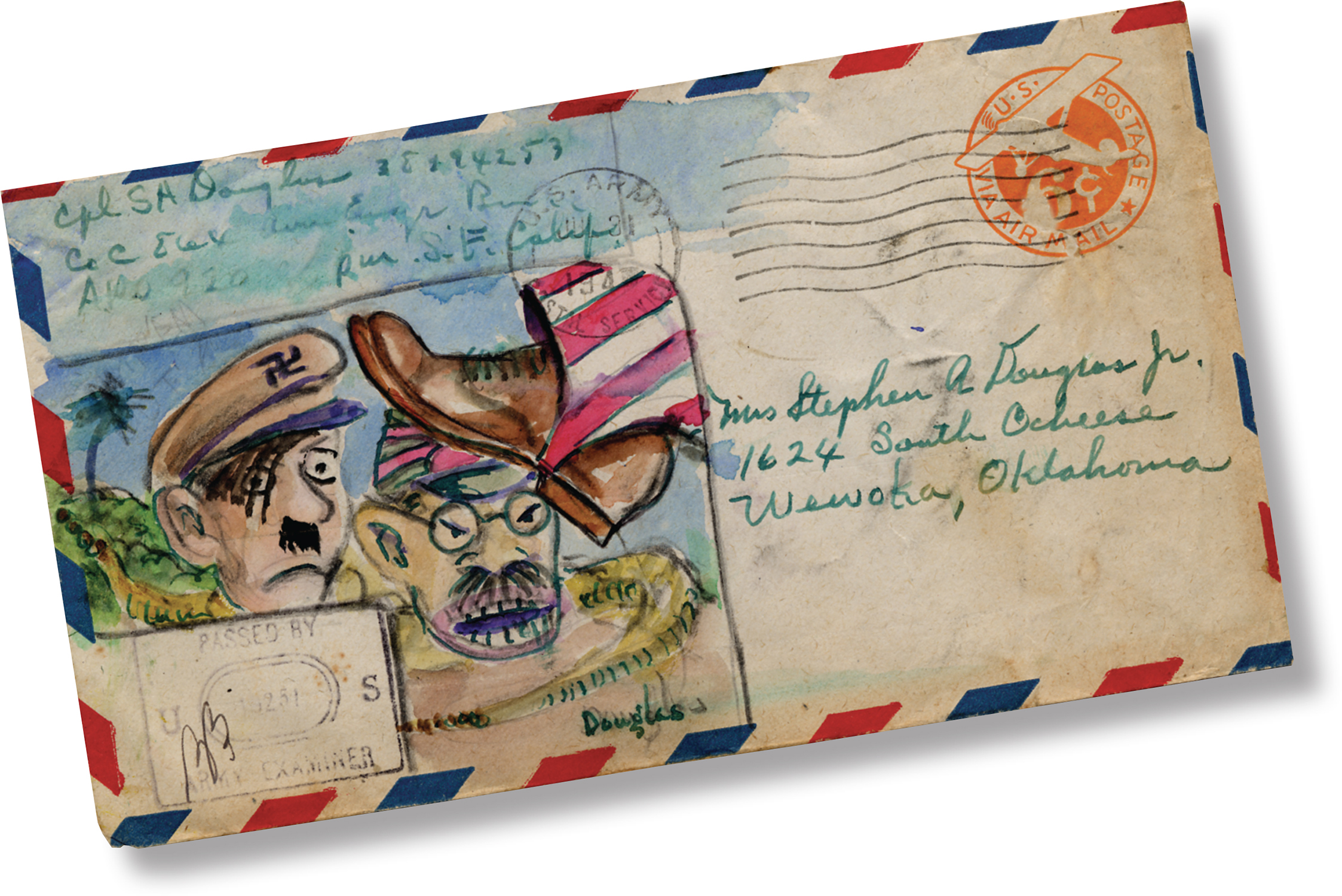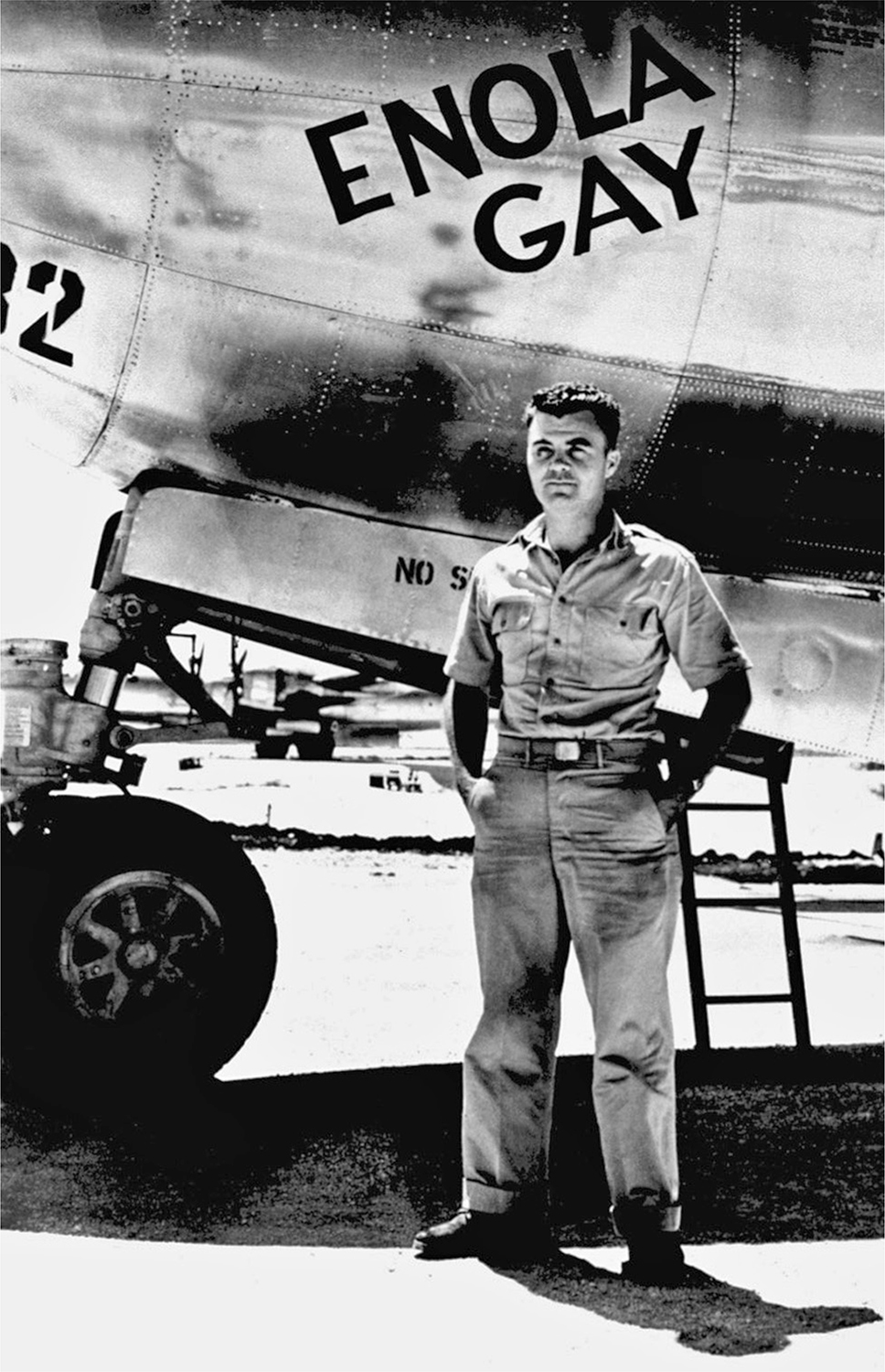The American Promise:
Printed Page 707
The American Promise Value
Edition: Printed Page 662
Chapter Chronology
Introduction for Chapter 25
The United States and the Second World War
1939–1945

GI MAIL Soldiers who engaged in deadly combat also stayed in touch with family and friends. The soldier who drew on this envelope emphasized that Uncle Sam was crushing the leaders of Germany and Japan. Stephen Douglas World War II Envelopes, Archives Center, National Museum of American History, Smithsonian Institution.
CONTENT LEARNING OBJECTIVES
After reading and studying this chapter, you should be able to:
- Describe the foreign policy dilemmas that confronted the United States during the interwar years.
- Explain which events led to the onset of war and why the United States became involved. Describe the United States’ war mobilization efforts.
- Outline the crucial military and diplomatic events of 1941 through 1943, demonstrating how the United States turned the tide in the Pacific and explaining its prime military objectives in the European theater.
- Analyze the impact of the war on American society including the effects it had on women and families, African Americans, and the 1944 presidential campaign.
- Assess which military and diplomatic events during 1943 to 1945 contributed to Allied victory in Europe and over Japan.
ON A SUN-DRENCHED FLORIDA AFTERNOON IN 1927, TWELVE-YEAR-OLD Paul Tibbets clambered into the front seat of the open cockpit of a biplane for his first airplane ride. While the pilot brought the plane in low over the Hialeah racetrack in Miami, Tibbets pitched Baby Ruth candy bars tethered to small paper parachutes to racing fans in the grandstands below. After repeating this stunt, sales of Baby Ruths soared, and Tibbets was hooked on flying.
In 1937, Tibbets joined the Army Air Corps and became a military pilot. Shortly after the Japanese attack on Pearl Harbor in December 1941 immediately overcame American isolationism and brought the United States into World War II, Tibbets flew on antisubmarine patrols against German U-boats lurking along the East Coast. When the heavily armored B-17 Flying Fortress bombers became available early in 1942, he took a squadron of the new planes to England. In August 1942, he led the first American daytime bombing raid on German-occupied Europe, releasing on railroad yards in northern France the first of some 700,000 tons of explosives dropped by American bombers during the air war in Europe.
After numerous raids over Europe, Tibbets was reassigned to the North African campaign. After eight months of combat missions, Tibbets returned to the United States and was ordered to test the new B-29 Super Fortress being built in Wichita, Kansas. The B-29 was much bigger than the B-17 and could fly higher and faster, making it ideal for the campaign against Japan. Tibbets’s mastery of the B-29 caused him to be singled out in September 1944 to command a top-secret unit training for a special mission.

Colonel Paul Tibbets Before taking off to drop the world’s first atomic bomb on Hiroshima, Tibbets posed on the tarmac next to his customized B-29 Super Fortress bomber, named Enola Gay in honor of his mother. A crew of eleven handpicked airmen accompanied Tibbets on the top-secret mission. © Bettmann/Corbis.
The mission was to be ready to drop on Japan a bomb so powerful that it might end the war. No such bomb yet existed, but American scientists and engineers were working around the clock to build one. In May 1945, Tibbets and his men went to Tinian Island in the Pacific, where they trained for their secret mission by flying raids over Japanese cities and dropping ordinary bombs. The atomic bomb arrived on Tinian on July 26, just ten days after a successful test explosion in the New Mexico desert. Nicknamed “Little Boy,” the bomb packed the equivalent of 40 million pounds of TNT, or 200,000 of the 200-pound bombs Tibbets and other American airmen had dropped on Europe.
On August 6, 1945, Tibbets, his crew, and their atomic payload took off in the B-29 bomber Enola Gay and headed for Japan. Less than seven hours later, over the city of Hiroshima, Tibbets and his men released Little Boy from the Enola Gay’s bomb bay. Three days later, airmen from Tibbets’s command dropped a second atomic bomb on Nagasaki, and within five days Japan surrendered.
Paul Tibbets’s experiences traced an arc followed by millions of Americans during World War II. Like Tibbets, Americans joined their allies to fight the Axis powers in Europe and Asia. Like his Enola Gay crewmen—who hailed from New York, Texas, California, New Jersey, New Mexico, Maryland, North Carolina, Pennsylvania, Michigan, and Nevada—Americans from all regions united to help defeat the fascist aggressors in Asia and Europe. American industries mobilized to produce advanced bombers along with enough other military equipment to supply the American armed forces and their allies. At enormous cost in human life and suffering—including millions of civilians killed in military actions and millions more exterminated in the Holocaust of the Nazi’s racist death camps—the war resulted in employment and prosperity to most Americans at home, ending the depression, providing new opportunities for women and African Americans, and ushering the nation into the postwar world as a triumphant economic and atomic superpower.
CHRONOLOGY
| 1935–1937 |
|
| 1936 |
- Nazi Germany occupies Rhineland.
- Italian armies conquer Ethiopia.
- Spanish civil war begins.
|
| 1937 |
- Japanese troops capture Nanjing.
|
| 1938 |
|
| 1939 |
- German troops occupy Czechoslovakia.
- Nazi-Soviet nonaggression pact.
- Germany’s attack on Poland begins World War II.
|
| 1940 |
- Germany invades Denmark, Norway, France, Belgium, Luxembourg, and the Netherlands.
- British and French evacuate from Dunkirk.
- Battle of Britain.
- Tripartite Pact.
|
| 1941 |
- Lend-Lease Act.
- Germany invades Soviet Union.
- Japanese attack Pearl Harbor.
|
| 1942 |
- Internment of Japanese Americans.
- Japan captures Philippines.
- Congress of Racial Equality founded.
- Battles of Coral Sea and Midway.
- Manhattan Project begins.
- U.S. forces invade North Africa.
|
| 1943 |
- Allied leaders demand unconditional surrender of Axis powers.
- U.S. and British forces invade Italy.
|
| 1944 |
|
| 1945 |
- Yalta Conference.
- Roosevelt dies; Vice President Harry Truman becomes president.
- Germany surrenders.
- United States joins United Nations.
- United States drops atomic bombs on Hiroshima and Nagasaki.
- Japan surrenders, ending World War II.
|

